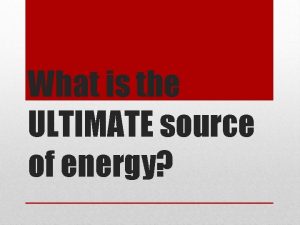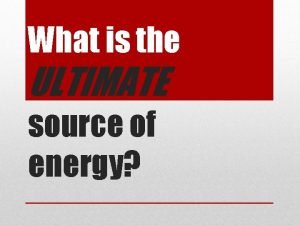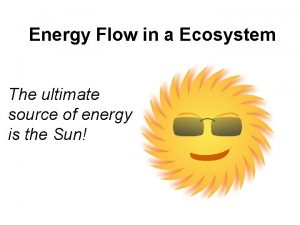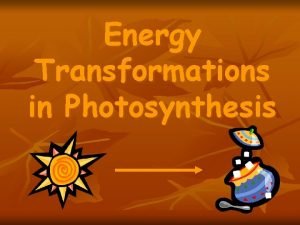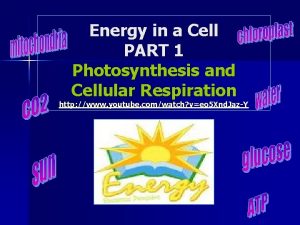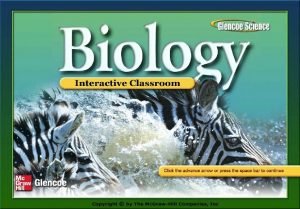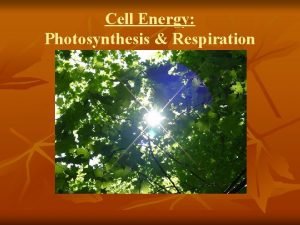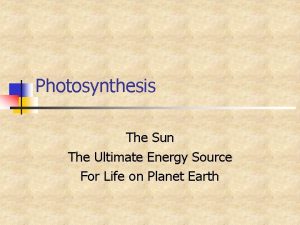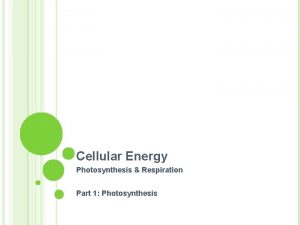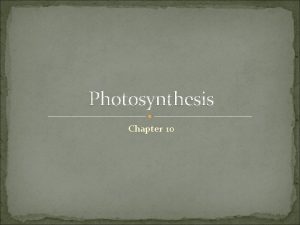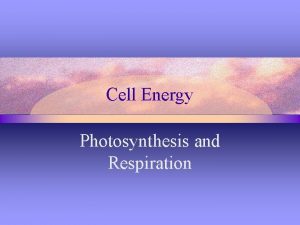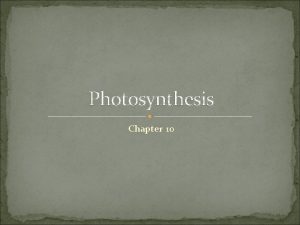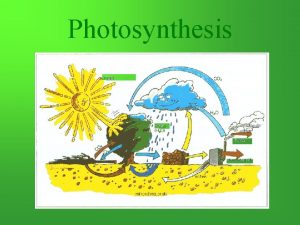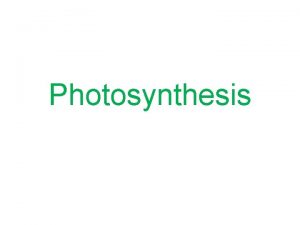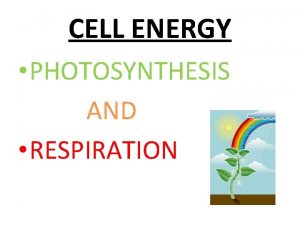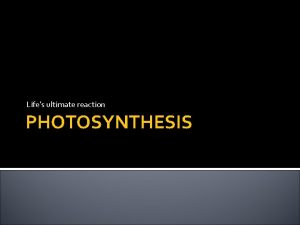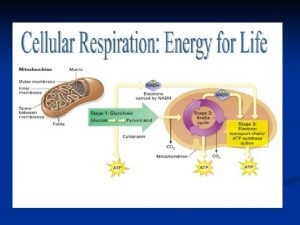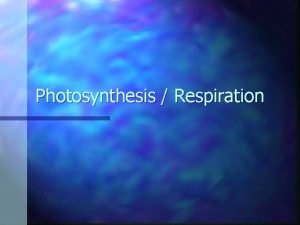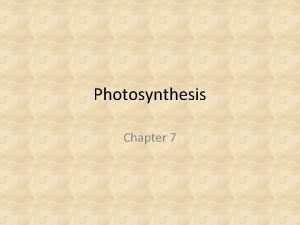Photosynthesis The Sun Ultimate Energy 1 5 x




































- Slides: 36

Photosynthesis

The Sun - Ultimate Energy • 1. 5 x 1022 k. J falls on the earth each day • 1% is absorbed by photosynthetic organisms and transformed into chemical energy • 6 CO 2 + 6 H 2 O C 6 H 12 O 6 + 6 O 2 • 1011 tons (!) of CO 2 are fixed globally per year • Formation of sugar from CO 2 and water requires energy • Sunlight is the energy source!

Photosynthesis: Light Reactions and Carbon Fixation • The light reactions capture light energy and convert it to chemical energy in the form of reducing potential (NADPH) and ATP with evolution of oxygen • During carbon fixation (dark reactions) NADPH and ATP are used to drive the endergonic process of hexose sugar formation from CO 2 in a series of reactions in the stroma Light: H 2 O + ADP + Pi + NADP+ + light O 2 + ATP + NADPH + H+ CF: CO 2 + ATP + NADPH + H+ Glucose + ADP + Pi + NADP+ Sum: CO 2 + light Glucose + O 2

Chloroplast • Inner and outer membrane = similar to mitochondria, but no ETC in inner membrane. • Thylakoids = internal membrane system. Organized into stromal and granal lammellae. • Thylakoid membrane - contains photosynthetic ETC • Thylakoid Lumen – aqueous interior of thylkoid. Protons are pumped into the lumen for ATP synthesis • Stroma – “cytoplasm” of chloroplast. Contains carbon fixation machinery. • Chloroplasts possess DNA, RNA and ribosomes


Conversion of Light Energy to Chemical Energy • Light is absorbed by photoreceptor molecules (Chlorophylls, carotenoids) • Light absorbed by photoreceptor molecules excite an electron from its ground state (low energy) orbit to a excited state (higher energy) orbit.

• The high energy electron can then return to the ground state releasing the energy as heat or light or be transferred to an acceptor. • Results in (+)charged donor and (–)charged acceptor = charge separation • Charge separation occurs at photocenters. • Conversion of light NRG to chemical NRG

Photosynthetic Pigments

Chlorophyll • Photoreactive, isoprenebased pigment • A planar, conjugated ring system - similar to porphyrins • Mg in place of iron in the center • Long chain phytol group confers membrane solubility • Aromaticity makes chlorophyll an efficient absorber of light • Two major forms in plants Chl A and Chl B

Accessory Pigments Carotenoid Phycobilin • Absorb light through conjugated double bond system • Absorb light at different wavelengths than Chlorophyll • Broaden range of light absorbed

Absorption Spectra of Major Photosynthetic Pigments

Harvesting of Light and Transfer of Energy to Photosystems • Light is absorbed by “antenna pigments” and transferred to photosystems. • Photosystems contain special-pair chlorophyll molecules that undergo charge separation and donate e- to the photosynthetic ETC

Resonance Transfer • Energy is transfer through antenna pigment system by resonance transfer not charge separation. • An electron in the excited state can transfer the energy to an adjacent molecule through electromagnetic interactions. • Acceptor and donor molecule must be separated by very small distances. • Rate of NRG transfer decreases by a factor of n 6 (n= distance betwn) • Can only transfer energy to a donor of equal or lower energy

Photosynthetic Electron Transport and Photophosphorylation • Analogous to respiratory ETC and oxidative phosphorylation • Light driven ETC generates a proton gradient which is used to provide energy for ATP production through a F 1 Fo type ATPase. • The photosynthetic ETC generates proton gradient across the thylakoid membrane. • Protons are pumped into the lumen space. • When protons exit the lumen and re-enter the stroma, ATP is produced through the F 1 Fo ATPase.

Photosynthetic ETC

Eukaryotic Photosystems • PSI (P 700) and PSII (P 680) • PSI and PSII contain special-pair chlorophylls • PSI absorbs at 700 nm and PSII absorbs at 680 nm • PSII oxidizes water (termed “photolysis") • PSI reduces NADP+ • ATP is generated by establishment of a proton gradient as electrons flow from PSII to PSI

Z-Scheme

The Z Scheme • An arrangement of the electron carriers as a chain according to their standard reduction potentials • PQ = plastoquinone • PC = plastocyanin • "F"s = ferredoxins • Ao = a special chlorophyll a • A 1 = a special PSI quinone • Cytochrome b 6/cytochrome f complex is a proton pump

P 680(PSII) to PQ Pool

Excitation, Oxidation and Re-reduction of P 680 • Special pair chlorophyll in P 680 (PS II) is excited by a photon • P 680* transfer energy as a e- to pheophytin A through a charge separation step. • The oxidized P 680+ is rereduced by e- derived from the oxidation of water

Oxygen evolution by PSII • Requires the accumulation of four oxidizing equivalents • P 680 has to be oxidized by 4 photons • 1 e- is removed in each of four steps before H 2 O is oxidized to O 2 + 4 H+ • Results in the accumulation of 4 H+ in lumen


Electrons are passed from Pheophytin to Plastoquinone • Plastoquinone is analagous to ubiquinone • Lipid soluble e- carrier • Can form stable semiquinone intermediate • Can transfer 2 electrons on at a time.

Transfer of e- from PQH 2 to Cytbf Complex (another Q-cycle) • Electrons must be transferred one at a time to Fe-S group. • Another Q-cycle • First PQH 2 transfers one electron to Fe-S group, a PQformed. 2 H+ pumped into lumen • A second PQH 2 transfers one electron to Fe-S group and the one to reduce the first PQ- to PQH 2. 2 more H+ pumped into lumen • 4 protons pumped per PQH 2. Since 2 PQH 2 produced per O 2 evolved 8 protons pumped


Terminal Step in Photosynthetic ETC • Electrons are transferred from the last iron sulfur complex to ferredoxin. • Ferredoxin is a water soluble protein coenzyme • Very powerful reducing agent. • Ferredoxin is then used to reduce NADP+ to NADPH by ferredoxin-NADP+ oxidoreductase • So NADP+ is terminal e- accepter

Photophosphorylation

Photophosphorylation • Light-Driven ATP Synthesis • Electron transfer through the proteins of the Z scheme drives the generation of a proton gradient across the thylakoid membrane • Protons pumped into the lumen of the thylakoids flow back out, driving the synthesis of ATP • CF 1 -CFo ATP synthase is similar to the mitochondrial ATP synthase


Chloroplast CF 1 CFo ATPase • Similar in structure to mitochondrial F 1 Fo ATPase • CF 1 domain (ATP synthesis) extends into the stroma. • Many of the protein subunits are encoded by the chloroplast genome

Chloroplast Proton Motive Force (Dp) • What contributes more to PMF, DY or Dp. H? • In the light Dp. H=3 • DY is negligible due to counter ion movement in and out of the lumen • DG for export of one mole H+ across thylakoid membrane = -17 k. J/mole • DGo’ for ATP formation = 30. 5 k. J/mole • Since 12 moles of protons gives – 200 k. J of energy • Experiment show that 3 ATPs are generated per mole of O 2 produced

Energy Balance Sheet • 8 photons (4 e-) generate 1 oxygen and 2 NADPH • Photosynthetic ETC pumps between 8 and 12 protons across thylakoid membrane to generate proton gradient (Dp. H ~3. 5). • Photophosphorylation produces 3 ATPs per O 2 produced

Non-cyclic photosynthetic ETC • NADPH and ATP produced • Involves both PSI and PSII cyclic photosynthetic ETC • only ATP produced • Involves only PSI

Cyclic Photosynthetic ETC • Involves only PSI • Reduced ferredoxin transfers e- to Cytobf complex which then re-reduces Plastocyanin and finally the oxidized P 700 of PSI • No NADPH produce. Only ATP • Levels of NADP+ thought to regulated this process. • Low NADP+ activates cyclic ETC • Observed in vitro.

Arrangement of photosystems in thylakoid membrane

Arrangement of photosystems in thylakoid membrane • PSII primarily present in granal lamellae • Light harvesting antennae complexes (LHC) are also present in the granal lamellae. • Under low light conditions LHCs are closely associated with PSII, Under high light condition the 2 disassociate. • PSI and ATPase are in the stroma lamellae. • Physical separation suggest that mobile electron carrier must be involved (i. e. PQ and Plastocyanin)
 Photosynthesis transforms light energy into chemical energy
Photosynthesis transforms light energy into chemical energy What is the ultimate source of energy for life on earth?
What is the ultimate source of energy for life on earth? What is the ultimate source of energy? *
What is the ultimate source of energy? * What is the ultimate energy for your food web
What is the ultimate energy for your food web Ultimate source of energy in an ecosystem
Ultimate source of energy in an ecosystem Energy energy transfer and general energy analysis
Energy energy transfer and general energy analysis Energy energy transfer and general energy analysis
Energy energy transfer and general energy analysis Radiant energy transformation
Radiant energy transformation Photosynthesis energy transformation
Photosynthesis energy transformation Cellular energy section 2 photosynthesis answer key
Cellular energy section 2 photosynthesis answer key Chapter 6 cell energy photosynthesis and respiration
Chapter 6 cell energy photosynthesis and respiration Hình ảnh bộ gõ cơ thể búng tay
Hình ảnh bộ gõ cơ thể búng tay Slidetodoc
Slidetodoc Bổ thể
Bổ thể Tỉ lệ cơ thể trẻ em
Tỉ lệ cơ thể trẻ em Gấu đi như thế nào
Gấu đi như thế nào Tư thế worms-breton
Tư thế worms-breton Hát lên người ơi
Hát lên người ơi Các môn thể thao bắt đầu bằng tiếng bóng
Các môn thể thao bắt đầu bằng tiếng bóng Thế nào là hệ số cao nhất
Thế nào là hệ số cao nhất Các châu lục và đại dương trên thế giới
Các châu lục và đại dương trên thế giới Công của trọng lực
Công của trọng lực Trời xanh đây là của chúng ta thể thơ
Trời xanh đây là của chúng ta thể thơ Cách giải mật thư tọa độ
Cách giải mật thư tọa độ Làm thế nào để 102-1=99
Làm thế nào để 102-1=99 độ dài liên kết
độ dài liên kết Các châu lục và đại dương trên thế giới
Các châu lục và đại dương trên thế giới Thơ thất ngôn tứ tuyệt đường luật
Thơ thất ngôn tứ tuyệt đường luật Quá trình desamine hóa có thể tạo ra
Quá trình desamine hóa có thể tạo ra Một số thể thơ truyền thống
Một số thể thơ truyền thống Cái miệng nó xinh thế chỉ nói điều hay thôi
Cái miệng nó xinh thế chỉ nói điều hay thôi Vẽ hình chiếu vuông góc của vật thể sau
Vẽ hình chiếu vuông góc của vật thể sau Thế nào là sự mỏi cơ
Thế nào là sự mỏi cơ đặc điểm cơ thể của người tối cổ
đặc điểm cơ thể của người tối cổ Ví dụ về giọng cùng tên
Ví dụ về giọng cùng tên Vẽ hình chiếu đứng bằng cạnh của vật thể
Vẽ hình chiếu đứng bằng cạnh của vật thể Fecboak
Fecboak

